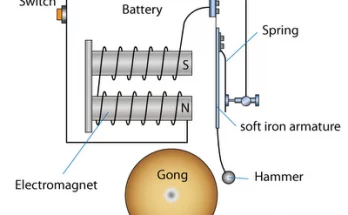Objective- This activity is designed to demonstrate the heating effect of electric current using nichrome wire and to explore its applications in everyday electrical appliances.
Concepts to Understand
- Heating Effect of Electric Current- This is the phenomenon where electric current passing through a conductor (like nichrome wire) produces heat.
- Resistance and Heat Generation- Nichrome wire is used because it has high resistance, which causes more heat to be generated when current flows through it.
Materials Needed-
- Nichrome wire (about 10 cm long)
- Two nails
- An electric cell
- A switch
- Connecting wires
Steps to Follow-
Setting Up the Circuit-

- Fix the two nails on a board, keeping a small gap between them.
- Tie the nichrome wire tightly between the nails, ensuring it’s stretched and not touching the board.
- Connect the wire from one end of the nichrome wire to the positive terminal of the cell.
- Connect another wire from the negative terminal of the cell to one terminal of the switch.
- Attach a third wire from the other terminal of the switch to the other end of the nichrome wire.
- Ensure all connections are secure and the switch is initially in the ‘OFF’ position.
Observing the Heating Effect-
- Before turning on the switch, touch the nichrome wire to feel its temperature.
- Now, turn the switch to the ‘ON’ position and observe the nichrome wire.
- After a few moments, carefully touch the nichrome wire again (be cautious as it might be hot).
Recording Observations-
- Note the change in temperature of the nichrome wire.
- Discuss why the wire gets hot when the current passes through it.
Understanding the Concept-
- The nichrome wire heats up due to the resistance it offers to the electric current. This resistance converts some of the electrical energy into heat energy.
- In everyday appliances, this heating effect is used intentionally. For example, in electric heaters, toasters, and hair dryers, the heating element is often made of nichrome wire or a similar high-resistance material.
Safety Precaution-
- Do not keep the switch in the ‘ON’ position for too long to prevent the cell from weakening quickly.
Conclusion-
This activity helps students understand the practical application of the heating effect of electric current, particularly how resistance in materials like nichrome wire can be utilised to generate heat. It also provides insights into the working principles of many household appliances.
Also Check – Chapter 10: A Detailed Guide to “Electric Current and its Effects” Activities for Class 7 Students
Also Check- Electromagnets- A Guide for Upper Primary Students
Also Check- Chapter 10 – Electric Current and its Effects – 5 Worksheets Solved and Unsolved
Also Check- Electric Bell Diagram for Class 7 Science
Also Check- Rapid Revision – Class 7 Science- Chapter 14 – Electric Current and Its Effects
Also Check- Chapter 14- Electric Current and Its Effects-Class 7 science- Question and Answers
Also Check- Chapter 14- Electric Current and Its Effects–Class 7 science- Question and Answer -(Solved MCQs)
Also Check- NCERT Exemplar Solutions- Class 7 Science- Chapter 14 – Electric Current and Its Effects
Also Check- NCERT Solutions for Class 7 Science Chapter 14- Electric Current and its Effects
Also Check- Class 7 science -Chapter 14 – Electric Current and Its Effects- Complete Notes
Also Check – Electric Bell Working Mechanism Simplified for Students
Also Check- Batteries- The Powerhouses of Everyday Life – A Guide for Upper Primary Students
